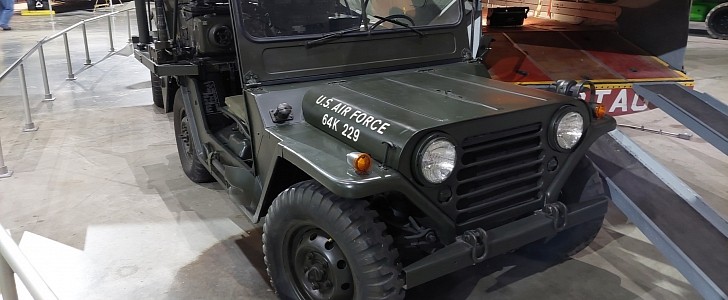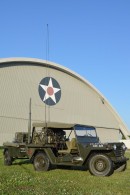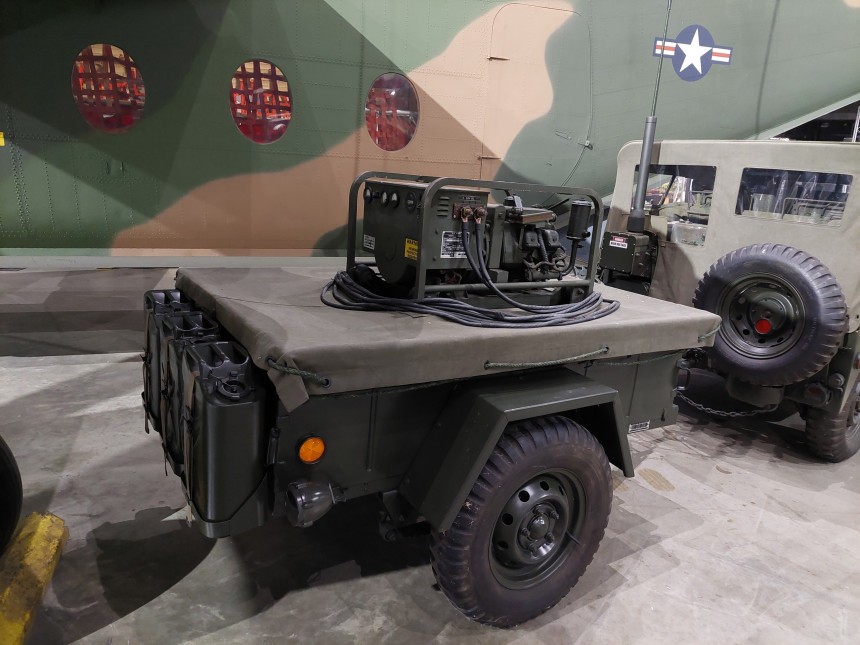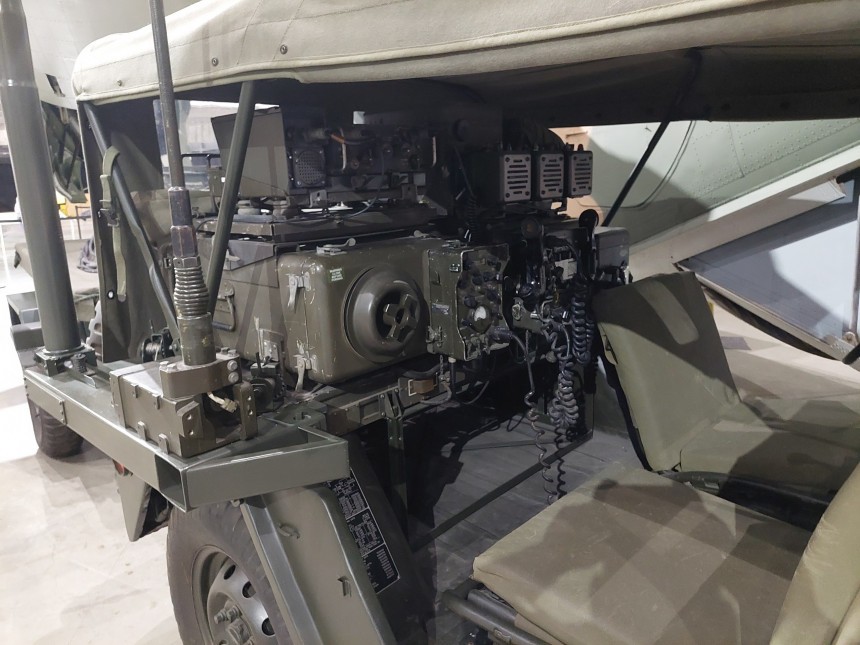When it comes to vehicle mods, you're pretty strapped when it comes to choices. You could turbocharge your engine or add a nice infotainment head unit, for example. But if you're the United States Military in Vietnam War-era Indo-China, your Jeep needed upgrades in other areas.
It's great luck that autoevolution's Tuning Month lined up perfectly with our trip to the National Museum of the United States Air Force in Dayton, Ohio because no self-respecting Air Force is complete without a hearty fleet of ground vehicles. This Ford M151-A1 Jeep represented its air armed forces with a communications array that would make any Second World War field commander jealous they didn't have access to one.
The M151 ¼-Ton Jeep represented the colossal dull mass of the U.S. Army from the early post-war days of Korea all the way until the HUMVEE replaced the fleet in the mid-'80s. As far as drivetrains, they were as simple as could be. Four cylinders, 141.5 cubic inches (2.3 liters), and a four-speed manual with four-wheel drive were all this little Jeep needed to move hundreds of thousands, if not millions of military personnel, active and in reserve.
What the Army asked of this little 4x4, now sitting happily alongside famous jets it fought alongside in the museum, was not to be fast, good looking, or fun to drive. Instead, its upgrades came in the form of the most advanced mobile communications system ever seen up to that point. One that was powerful enough to direct traffic from both ground and air forces on two entirely different frequencies.
This astounding technology came from the U.S. Air Force Electronic Systems Division's AN/MRC-108 Comms Array. (Man, that's a mouthful). The platform was fully operational by the mid-1960s, just in time for things to heat up in Southeast Asia. This system used ultra-high frequency (UGF) and very high frequency (UHF) radio capabilities to relay important information like enemy positions related to friendly positions to prevent friendly fire incidents, for one example.
In its close air support role (CAS), A Radio Operation, Maintainer, and Driver (ROMAD), drove the 4x4 to stay in proximity to aircraft and ground force radio signals while forward air controllers (FACs) in AWACS planes like the Grumman E-3 Sentry, directed pilots when and where to strike targets. In-tow behind the little Jeep is the M416 antenna array and gasoline-generator for operations away from base locations. Seeing that the trailer is about half the size of the thing carrying it is humorous if you're just a museum-goer.
Still, in the field, the extra horsepower in the comms department was vital to American operations in Vietnam, even if the horsepower under the hood was sub-par at best. In high-stress situations like the Viet-cong siege of Khe Sa in South Vietnam, these rugged little vehicles could serve as command hubs for close air support aircraft (CAS). Planes like the A-7 Corsair II, F-4 Phantom II, or A-1 Skyraider attack aircraft and strategic bombers like the B-57 Canberra and B-52 Stratofortress.
Both truck and trailer are decked out in a period-correct Army-green paint scheme with matching sets of period-looking chunky off-road tires. The interior is less than current G-Wagon levels of comfort. To be kind to it. But the wacky rear-facing passenger seat serves a good purpose. It serves at a captain's chair in front of one of the most powerful pieces of communication equipment available in the late 60s and early 70s. Before the days of satellites, this role was more vital than one could even imagine.
Due to trademark and copyright issues, the M151 did not sport the distinctive verticle slotted grille. The Ford-derived design would feature a 90 degree flip of the front grille slots to a straight-horizontal arrangement. Independent suspension and coil springs replaced the dual live-rear-axles found in most World War II Army Jeeps, which would serve this mobile comms platform very well navigating the harsh jungle terrain of Indo-China.
The last M151 rolled off the factory floor in 1988, a total operating lifespan nearly stretching to five calendar decades. Many of the aircraft that the Jeep served within its time as a mobile command post would go on to have far shorter lifespans than the adorable little off-roader tasked with relaying them valuable instructions, although not the B-52, obviously.
So then, this little Jeep isn't a modified vehicle in the traditional sense, at least. But in a world where tuner culture extends to the kit inside as much as it does to the engine or exterior, it's more or less the Cold War's U.S. Military's vision of a pimped-out road car with speakers and T.V. screens galore today.
A modern Civic with a tricked-out sound system may very well use up as much power as this Jeep's trailer's gas-generator used. At least the Civic didn't require such a thing, so, hurray, we suppose. Check out the slideshow above if you want to see more of this highly unusual Jeep, and stay tuned for more content for Tuning Month and more coverage of our trip to the National Museum of the U.S. Air Force in Dayton, Ohio, here on autoevolution.
The M151 ¼-Ton Jeep represented the colossal dull mass of the U.S. Army from the early post-war days of Korea all the way until the HUMVEE replaced the fleet in the mid-'80s. As far as drivetrains, they were as simple as could be. Four cylinders, 141.5 cubic inches (2.3 liters), and a four-speed manual with four-wheel drive were all this little Jeep needed to move hundreds of thousands, if not millions of military personnel, active and in reserve.
What the Army asked of this little 4x4, now sitting happily alongside famous jets it fought alongside in the museum, was not to be fast, good looking, or fun to drive. Instead, its upgrades came in the form of the most advanced mobile communications system ever seen up to that point. One that was powerful enough to direct traffic from both ground and air forces on two entirely different frequencies.
This astounding technology came from the U.S. Air Force Electronic Systems Division's AN/MRC-108 Comms Array. (Man, that's a mouthful). The platform was fully operational by the mid-1960s, just in time for things to heat up in Southeast Asia. This system used ultra-high frequency (UGF) and very high frequency (UHF) radio capabilities to relay important information like enemy positions related to friendly positions to prevent friendly fire incidents, for one example.
Still, in the field, the extra horsepower in the comms department was vital to American operations in Vietnam, even if the horsepower under the hood was sub-par at best. In high-stress situations like the Viet-cong siege of Khe Sa in South Vietnam, these rugged little vehicles could serve as command hubs for close air support aircraft (CAS). Planes like the A-7 Corsair II, F-4 Phantom II, or A-1 Skyraider attack aircraft and strategic bombers like the B-57 Canberra and B-52 Stratofortress.
Both truck and trailer are decked out in a period-correct Army-green paint scheme with matching sets of period-looking chunky off-road tires. The interior is less than current G-Wagon levels of comfort. To be kind to it. But the wacky rear-facing passenger seat serves a good purpose. It serves at a captain's chair in front of one of the most powerful pieces of communication equipment available in the late 60s and early 70s. Before the days of satellites, this role was more vital than one could even imagine.
Due to trademark and copyright issues, the M151 did not sport the distinctive verticle slotted grille. The Ford-derived design would feature a 90 degree flip of the front grille slots to a straight-horizontal arrangement. Independent suspension and coil springs replaced the dual live-rear-axles found in most World War II Army Jeeps, which would serve this mobile comms platform very well navigating the harsh jungle terrain of Indo-China.
So then, this little Jeep isn't a modified vehicle in the traditional sense, at least. But in a world where tuner culture extends to the kit inside as much as it does to the engine or exterior, it's more or less the Cold War's U.S. Military's vision of a pimped-out road car with speakers and T.V. screens galore today.
A modern Civic with a tricked-out sound system may very well use up as much power as this Jeep's trailer's gas-generator used. At least the Civic didn't require such a thing, so, hurray, we suppose. Check out the slideshow above if you want to see more of this highly unusual Jeep, and stay tuned for more content for Tuning Month and more coverage of our trip to the National Museum of the U.S. Air Force in Dayton, Ohio, here on autoevolution.












